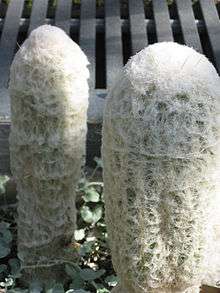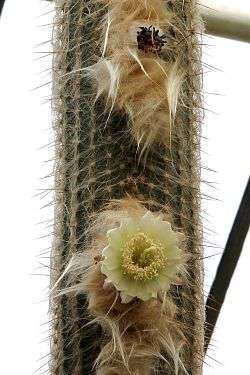Espostoa melanostele
| Espostoa melanostele | |
|---|---|
 | |
| Scientific classification | |
| Kingdom: | Plantae |
| (unranked): | Angiosperms |
| (unranked): | Eudicots |
| (unranked): | Core eudicots |
| Order: | Caryophyllales |
| Family: | Cactaceae |
| Subfamily: | Cactoideae |
| Tribe: | Trichocereeae |
| Genus: | Espostoa |
| Species: | E. melanostele |
Espostoa melanostele is a species of rare,[1] endangered, long-lived, slow-growing plant in the Cactaceae family.
Endangerment
Horticultural collection and the fact that the plant is slow growing contribute to the fact that the plant is endangered.
Drought tolerance
This xerophyte is tolerant of most droughts when mature.
Description and care
E. melanostele is a columnar cactus native to Peru. Spines easily detach from the plant. In rain, flowers close up completely. When dry, flowers open up again. Petals are usually joined in the wild, but some cultivated forms have prominently separated petals. Flowers are yellow and diurnal, unlike E. lanata. They start opening up in morning and stay open until evening, when they start to close up again for night. They are pollinated by insects. The fruit is edible, sweet, and juicy. A boost in growth is usually given by putting worm castings (earthworm feces) in the soil that the plant is living in. Care for the plant is no different from caring for other Espostoas.
Uses
The plant is not only used for its fruit, but also grown for decorative qualities, such as its yellow flowers and its white ''fleece''.
Cultivars
A cultivar, E. melanostele 'Peruvian old lady', is so-named because of its resemblance to an old lady (especially when flowering and fruiting).
Hazards
The spines may be considered a hazard to children, but actually come off the skin very easily with proper handling.
Common names
Common names include ''Cactus strawflower'' and ''Old lady cactus''.
References
- CX Furtado, (1964). Concerning the types of genera, Taxon.
